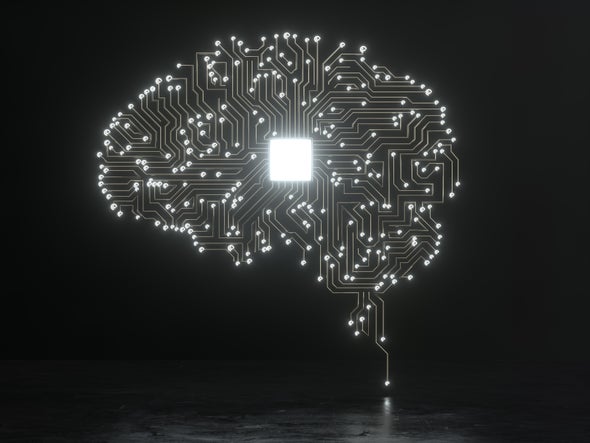What Would Happen If We Upload Our Brains To Computers

Decision-making animal movements with your thoughts lone. Monitoring a pupil's attending in course with a headset that scans brain activity. And, of course, the much more familiar cochlear implants that help the deaf hear or deep-brain stimulators that assist people with Parkinson's disease to regain functional mobility.
This is neurotech—new, potentially revolutionary applied science that promises to transform our lives. With all the global challenges of today, nosotros need revolutionary technology to help the world cope.
Neurotech is our, bluntly, mind-bravado endeavor to connect homo brains to machines, computers and mobile phones. Although encephalon-computer interfaces (BCIs) are the heart of neurotech, it is more than broadly defined as technology able to collect, interpret, infer or modify information generated past whatever part of the nervous system. Why? To develop therapies for mental illnesses and neurological diseases. Beyond health care, it could presently be used in education, gaming, amusement, transportation and then much more.
Merely there are pitfalls: in that location are no widely accustomed regulations or guardrails nonetheless when it comes to neurotech's development or deployment. Nosotros need them—we need them bad. We must accept principles and policies around neurotech, applied science safeguards, and national and international regulations.
WHAT IS NEUROTECH, Anyhow?
There are unlike types of it—some is invasive, some isn't. Invasive encephalon-reckoner interfaces involve placing microelectrodes or other kinds of neurotech materials direct onto the brain or fifty-fifty embedding them into the neural tissue. The idea is to directly sense or modulate neural activity.
Such engineering science has already improved the quality of life and abilities of people with different illnesses or impairments, from epilepsy to Parkinson's Illness to chronic pain. One twenty-four hours, nosotros might implant such neurotech devices into paralyzed humans, allowing them to easily control phones, computers and prosthetic limbs—with their thoughts alone. In 2017, Rodrigo Hübner Mendes, a paraplegic, used neurotech to drive a racecar with his listen. Recently, an invasive neurotech device accurately decoded imagined handwriting movements in real fourth dimension, at a speed that matched typical typing. Researchers have also showed how invasive neurotech allows users with missing or damaged limbs to feel affect, heat and common cold through their prostheses.
There is also noninvasive neurotech that can exist used for like applications. For example, researchers have developed wearables to infer a person'due south intended speech or movement. Such technology could eventually enable a patient with linguistic communication or movement difficulties—say, someone with locked-in syndrome—to communicate easier and more effectively.
Noninvasive neurotech is as well used for hurting management. Together with Boston Scientific, IBM researchers are applying auto learning, the net of things, and neurotech to improve chronic pain therapy.
All of this is already quite impressive, but there is also neurotech that actually pushes the envelope. Non only it can sense or read neurodata but it can besides attune—invasively and noninvasively. This research is still in early stages, but it'south advancing rapidly.
One phenomenal instance is the piece of work of Rafael Yuste, a neurobiologist at Columbia University. His team has recorded the neuron activity of a mouse that was performing an activeness, such equally licking for a reward. Later the researchers reactivated these aforementioned neurons and got the mouse to perform the same activity, even if the rodent did not intend to do it at that moment. Other neuroscientists have used like technologies to transfer learned tasks between 2 rodents brain-to-brain and implant false memories into an animal'southward mind. It's remarkable.
RISKS, Ideals AND REGULATION
Nevertheless, neurotech is at the very dawn of its technological journey. Every bit it becomes more commonplace, we must consider the risks it might present, the ethics effectually it, and the necessary regulation. We have to anticipate and deal with the implications related to the development, deployment and use of this technology. Whatsoever neurotech applications should consider potential consequences for the autonomy, privacy, responsibility, consent, integrity and dignity of a person.
What if someone were to face employment discrimination considering the algorithms that power a neurotech application used for hiring misinterpret his or her neurodata? What if a criminal gets a hold of the previous or current neurodata of the secretary of defense and steals top secret information? Ethical concerns increment when we are not simply monitoring someone's neurodata only also interpreting it, decoding the person'due south thoughts—with implications for accuracy and mental privacy.
I tricky aspect is that most of the neurodata generated past the nervous systems is unconscious. It means it is very possible to unknowingly or unintentionally provide neurotech with data that one otherwise wouldn't. So, in some applications of neurotech, the presumption of privacy within one'south own mind may merely no longer be a certainty.
As new, emerging technology, neurotech challenges corporations, researchers and individuals to reaffirm our commitment to responsible innovation. It's essential to enforce guardrails and then that they atomic number 82 to benign long-term outcomes—on company, national and international levels. Nosotros demand to ensure that researchers and manufacturers of neurotech too as policymakers and consumers approach it responsibly and ethically.
Let's deed at present to avoid any future risks every bit neurotech matures—for the benefit of humanity.
Source: https://www.scientificamerican.com/article/the-ethical-challenges-of-connecting-our-brains-to-computers/
Posted by: strohcoustruste.blogspot.com

0 Response to "What Would Happen If We Upload Our Brains To Computers"
Post a Comment